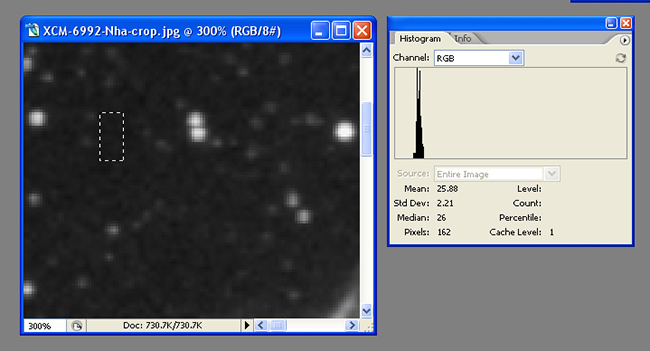Color vs. Mono Camera Match
SBIG ST-2000XCM color camera vs. the ST-2000XM mono w/filters
H-Alpha Performance
This test compares the performance of both cameras to record H-alpha emissions lines. A 48mm Astronomik 13nm Ha was used on both cameras. The XM camera had the luminance filter removed from the filter wheel to keep the number of glass
surfaces the same.
Though the XCM color camera isn't meant to be used for imaging H-alpha emission lines, this test was performed to show that it can be done but at the expense of more noise
and loss in spatial resolution caused by the Bayer matrix mask that allows only 25% of the red photons through as shown in the diagram below.
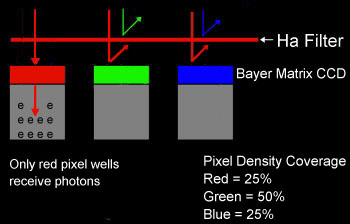
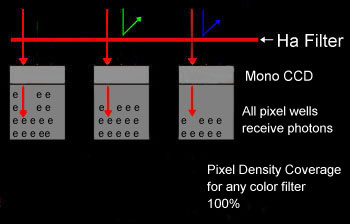
These are the full resolution cropped centers of the Bubble Nebula. Using Images Plus, only calibration and a common point structure reference for DDP were applied with no attempt to clean up noise, hot or cold pixels. The XCM version had to be stretched more due to the lower brightness.
Clearly shown the XM mono CCD performs much better with higher S/N and tighter star shapes and resolution for the same exposure times. There is also more finely resolved details in the XM version.
This is due to the fact that 100% of the pixels receive photons which increases spatial resolution.
But this doesn't mean the XCM Ha data can't be used. It will need to be cleaned up to reduce the noise and also sharpened to improve detail and cleaner star edges.
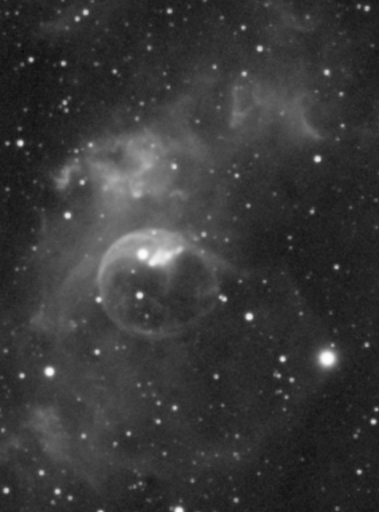
|
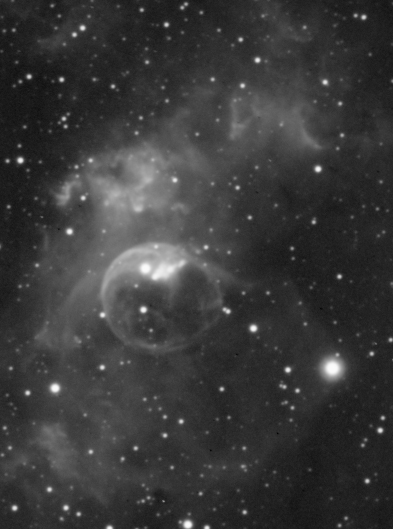
|
|
Full scale center crop of the Bubble Nebula taken with the XCM camera.
|
Full scale center crop of the Bubble Nebula taken with the XM camera.
|
ST2000-XCM Ha data details:
- Date - 9/24/2007 08:22PM
- Temp - 64F 18C
- Humidity - 60%
- Dew - 50F
- Visibility - 10 miles 16 Km
- Wind - 5 mph 8 Km/h
- Exposure - 10 X 15 minutes Bin 1x1
- Sigma Median Combine
- CCD Temp -15C
- OTA - TMB130SS APO w/Astronomik 13nm Ha filter
- Image scale 1.68 arc seconds/pixel
|
ST2000-XM Ha data details:
- Date - 9/23/2007 08:30PM
- Temp - 68F 20C
- Humidity - 46%
- Dew - 46F
- Visibility - 10 miles 16 Km
- Wind - 8 mph 13 Km/h
- Exposure - 10 X 15 minutes Bin 1x1
- Sigma Median Combine
- CCD Temp -15C
- OTA - TMB130SS APO w/Astronomik 13nm Ha filter
- Image scale 1.68 arc seconds/pixel
|
Noise Reduction Comparisons
Below are the same 2 images equally done with one pass of Adobe noise reduction and an unsharp mask with a 2.5 pixel radius @ 20%.
The XCM image cleaned up nicely and shows more details in various parts of the structure, but the XM still shows finer details, tighter stars and lower noise.
Additional processing will be needed to further bring out details with the XCM version.
The XCM Ha image can still be used to compliment a one-shot color image with good results depending on the type of object imaged.
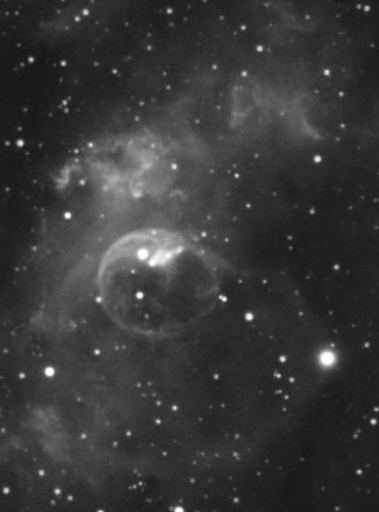
|
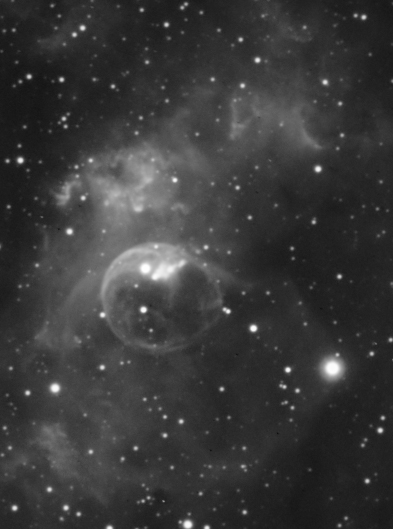
|
|
Full scale center crop of the (XCM) Bubble Nebula with NR and sharpening
|
Full scale center crop of the (XM) Bubble Nebula with NR and sharpening.
|
Finer Resolution Measurements - here is where it gets interesting
These are full resolution cropped centers of the Crab Nebula taken with a hydrogen alpha filter to demonstrate differences in more finer detail resolution.
Using Images Plus, calibration and DDP were applied with no attempt to clean up noise or hot and cold pixels. The XCM version had to be stretched further
to bring out the fainter outer areas for comparison which caused the stars to bloat more. Notice in the XCM version with small stars very close to each other show more jagged edges.
This is the result of only 25% of the pixels receiving photons which can't accurately record the smaller star shapes and the inability of the de-bayering algorithm to reconstruct it accurately. Pixel size and focal length has an effect on this in
regards to sampling rate. Longer focal lengths may help reduce star artifacts due to the stars energy being spread out over more pixels.
As previously mentioned the XCM isn't designed for or efficient at Ha imaging due to the limitation of the Bayer mask and its loss of resolution capability. These images shown are meant to dramatize
the differences in finer detail resolution capability between a CCD which all pixels receive photons and a CCD which only 25% receive photons.
The XM data was taken with higher humidity and less visibility compared to the XCM data and yet it came out displaying much more finer details.
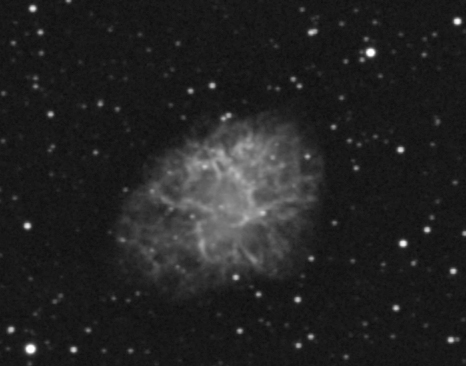
|
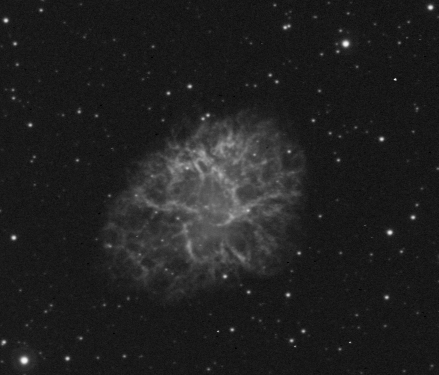
|
|
Full scale center crop of the Crab Nebula taken with the XCM camera.
|
Full scale center crop of the Crab Nebula taken with the XM camera.
|
ST2000-XCM H-alpha data details:
- Date - 11/04/2007 12:30AM
- Temp - 41F 5C
- Humidity - 56%
- Dew - 26F -3C
- Visibility - 10 miles 16.1Km
- Wind - 6 mph 10 Km/h
- Exposure - 12 X 15 minutes Bin 1x1
- Sigma Median Combine
- CCD Temp -25C
- OTA - TMB130SS APO w/Astronomik 13nm HA filter
- Image scale 1.68 arc seconds/pixel
|
ST2000-XM H-alpha data details:
- Date - 10/30/2007 1:45AM
- Temp - 43F 6C
- Humidity - 80%
- Dew - 38F 3C
- Visibility - 4 miles 6.4 Km
- Wind - Calm
- Exposure - 12 X 15 minutes Bin 1x1
- Sigma Median Combine
- CCD Temp -25C
- OTA - TMB130SS APO w/Astronomik 13nm HA filter
- Image scale 1.68 arc seconds/pixel
|
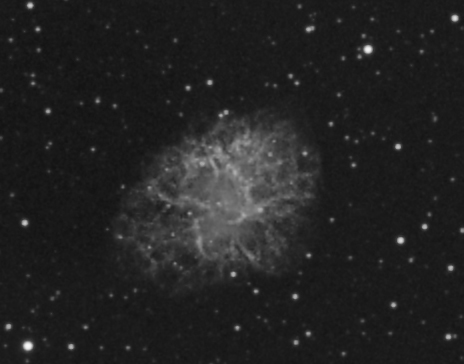
|
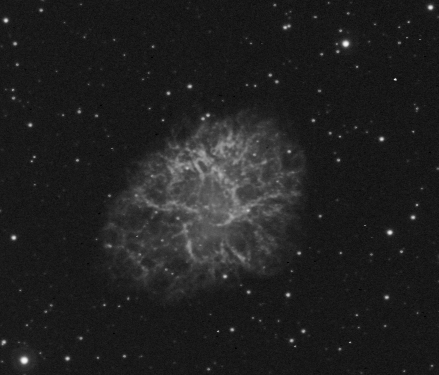
|
|
XCM image after 20 passes of adaptive Richardson-Lucy deconvolution were applied using Images Plus.
More filament details are seen but the artifacts around the stars within the structure are also enhanced. This will require further processing to reduce the noise and clean up star artifacts.
|
XM image after only 3 passes of adaptive Richardson-Lucy deconvolution was applied using Images Plus. Not much processing is needed here.
|
How much detail loss with the XCM with H-alpha use?
We can get a rough estimate of detail loss percentage. Using Images Plus, the higher resolution mono Ha version was binned 2x2 using average mode to reduce the resolution then upscaled 2X using bicubic mode.
The end results are practically the same as the XCM version. This roughly equates to the fine resolution capability of approximately 25% of the mono CCD.
Maybe not apparent with objects such as gaseous nebulas, but with very fine details the results are very obvious.
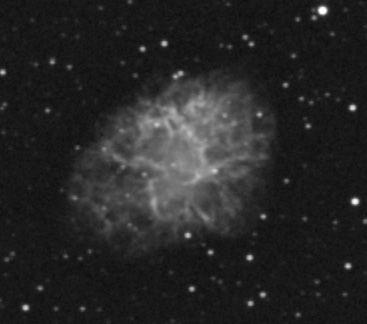
|
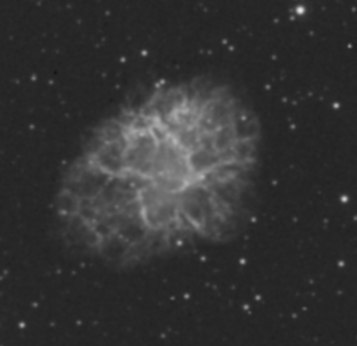
|
|
Center crop of the Crab Nebula taken with the XCM camera.
|
Center crop of XM version binned 2x2 then upscaled 2X using bicubic mode.
|
Star Artifacts and S/N
The below H-alpha images are of NGC6992. Processing was limited to calibration and DDP.
The XCM version displays jagged star edge artifacts due to the lower 25% pixel density. This loss of data effects the debayering reconstruction process which works better when green and blue data is present.
Using the XCM without the H-alpha filter does not produce these as there are blue and green photons being captured in the sky background as well
as from the stars emissions.
Also notice the softer details in the XCM version compared to the XM.
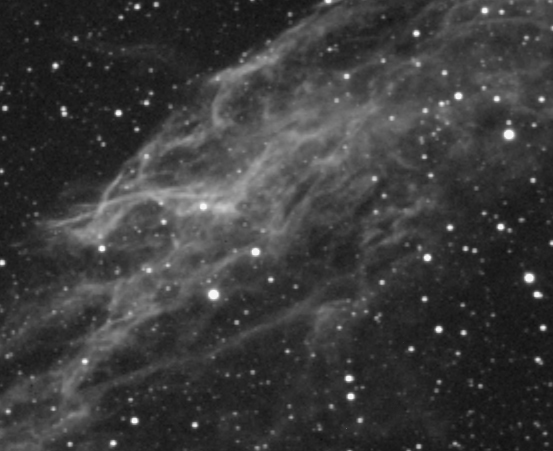
|
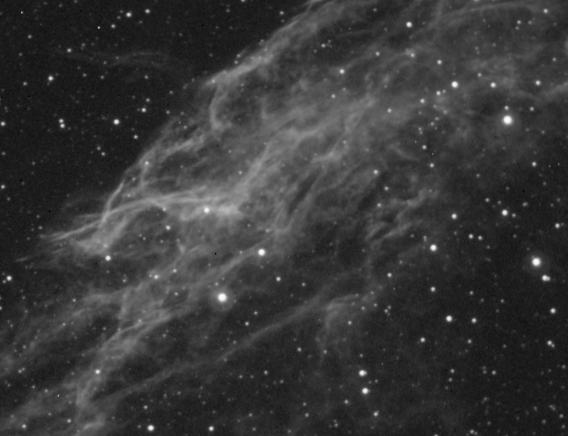
|
|
Portion of NGC6992 taken with the XCM camera.
|
Portion of NGC6992 taken with the XM camera.
|
ST2000-XCM H-alpha data details:
- Date - 11/06/2007 12:30AM
- Temp - 41F 5C
- Humidity - 58%
- Dew - 27F -3C
- Visibility - 10 miles 16.1Km
- Wind - 7 mph 11 Km/h
- Exposure - 9 X 15 minutes Bin 1x1
- Sigma Median Combine
- CCD Temp -25C
- OTA - TMB130SS APO w/Astronomik 13nm HA filter
- Image scale 1.68 arc seconds/pixel
|
ST2000-XM H-alpha data details:
- Date - 11/30/2007 1:45AM
- Temp - 44F 7C
- Humidity - 80%
- Dew - 41F 5C
- Visibility - 7 miles 11.3 Km
- Wind - Calm
- Exposure - 9 X 15 minutes Bin 1x1
- Sigma Average Combine
- CCD Temp -25C
- OTA - TMB130SS APO w/Astronomik 13nm HA filter
- Image scale 1.68 arc seconds/pixel
|
|
H-Alpha Performance Summary
I found the results of the XCM's H-alpha data for M1 to be drastically different compared to the XM mono CCD so I took a second data set of XCM H-alpha and the results were exactly the same.
The above comparison shows that if an object is a gaseous nebula, which many nebular are, then the XCM can perform quite well as its XM counter part.
But if the details are more finer, then the limitations of the Bayer matrix XCM are easily seen. This is true for any Bayer matrix camera regardless of the vendor.
Further processing of the XCM can be done to bring out the finer details but it still will be limited when compared to the XM mono sensor in this regards. This is something to consider before deciding on which type of camera to purchase and your intended use and if it may involve narrow band imaging.
|














